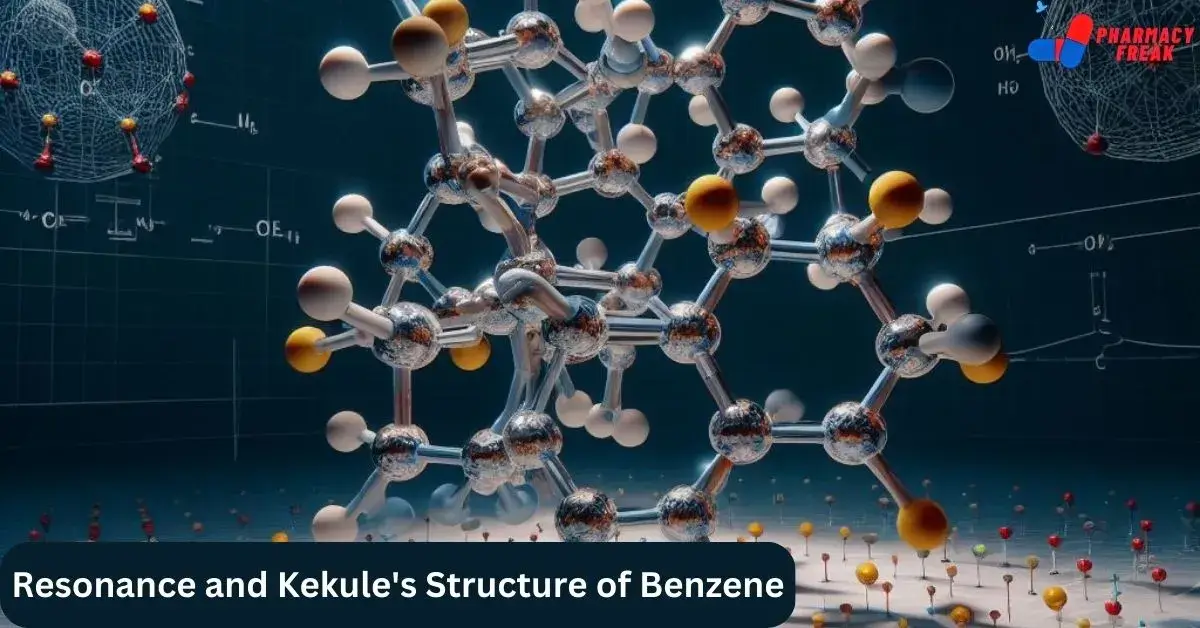Table of Contents
Kekule’s structure of benzene
Frederick August Kekule gave Kekule’s structure of benzene in 1865. He stated that the six carbon atoms of benzene attach with alternate single and double bonds and form hexagonal rings. Each carbon is further connected to a hydrogen atom. However, there are three main objections to Kekule’s structure. The three main limitations are 1- this structure could not explain the stability of benzene towards oxidizing agents and cannot explain the substitution reactions after having three double bonds. 2- according to this structure, only one monosubstituted and 2D substituted product exists but in actuality, only one monosubstituted product is known. The positions of single and double bonds are not fixed.
They oscillate back and forth which is not explained by Kekule’s structure. 3- Kekule’s formula for benzene contains two kinds of bonds that are single bond and double bonds but X-ray diffraction shows that benzene is a regular hexagon with an angle of 120 degrees and all the carbon-carbon bond lengths are equal
Resonance structure
To clarify all the limitations of Kekule’s structure, scientists have proposed that benzene is a resonance hybrid of two Kekule’s structures. These two Kekule’s structures are canonical forms of benzene. Benzene is a resonance hybrid of two structures. The benzene molecule’s two adjacent carbon atoms are joined neither by a pure single bond nor a pure double bond. As a result, all the carbon-carbon bond lengths are equal which is 1.39 angstrom, and lie between carbon=carbon double bond length of 1.34 angstrom and carbon-carbon single bond length of 1.54 angstrom.
Resonance hybrid is always more stable than its canonical structure. This is the reason why benzene is more stable than either of the two Kekule’s structures. The resonance structure of benzene explains all the facts like unusual stability and equality of carbon-carbon bond lengths in benzene.
Molecular orbital structure of benzene
All the carbon atoms of benzene are supposed to be SP2 hybridized. Each carbon atom forms 2 carbon-carbon Sigma bonds with the adjacent carbon atoms and one c-h sigma bond with a hydrogen atom. So overall, there are six carbon-carbon Sigma bonds and 6 C-H Sigma bonds which lie in one plane and the angle between two adjacent sigma bonds is 120 degrees. Each carbon atom has an unhybridized p-orbital. Therefore, six unhybridized p-orbitals have an electron each which are parallel and perpendicular to the plane of Sigma bonded carbon skeleton. Therefore, p-orbitals can overlap on adjacent carbon atoms to form three pi bonds. Each 2P orbitals overlap well with adjacent 2P orbitals on either side to form two doughnut-shaped Pi electron clouds. One lies above and the other below the plane of carbon and hydrogen atoms.
When six 2p orbitals have electrons combined 6 molecular orbitals, three of which are bonding while the remaining three are anti-bonding. Bonding orbitals are of the lowest energy so all the six pi electrons occupy three bonding molecular orbitals and are delocalized over the entire conjugated system. Pi-electrons’ involvement in forming more than one bond is called the delocalization of electrons. This delocalization makes the molecule more stable so benzene can be represented as a hexagon with a circle in the center. The circle represents the six completely delocalized pi-electrons.

I am a Registered Pharmacist under the Pharmacy Act, 1948, and the founder of PharmacyFreak.com. I hold a Bachelor of Pharmacy degree from Rungta College of Pharmaceutical Science and Research. With a strong academic foundation and practical knowledge, I am committed to providing accurate, easy-to-understand content to support pharmacy students and professionals. My aim is to make complex pharmaceutical concepts accessible and useful for real-world application.
Mail- Sachin@pharmacyfreak.com
